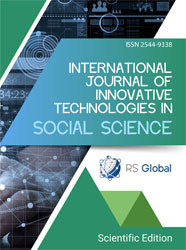URBAN REGENERATION OF LARGE HOUSING ESTATES THROUGH THE HQE²R APPROACH – CASE OF BAB EZZOUAR (ALGIERS)
Abstract
This article aims to adapt HQE²R approach to the Algerian “large housing estates”, through urban regeneration as a catch-up project. These neighborhoods constitute today a large stock of housing, mostly in decay, which deserves to be renewed. Nevertheless, they remain desirable neighborhoods due to their strategic urban location. The methodology consists of establishing a shared diagnosis model of sustainable development called HQDIL for detailed description of ZHUN Soummam according to urban actors, then an SD indicators assessment model called INDI as a decision support tool for the benefit of local authorities and their partners. In our study, we opted for INDI-2012 repository as a new operational tool which makes it possible to produce sustainability profiles through 127 composite indicators and 234 secondary indicators, first of all for an initial diagnosis, then by drawing up a potential scenario which describes the contribution of the urban regeneration project to improving the quality of life. Perceived visually, the neighborhood’s critical state with regard to the SD objectives was confirmed following the results of the assessment by themes, especially the indicators dealing with the quality of life of the inhabitants. The potential scenario for the urban regeneration project showed a very satisfying sustainability profile, if an action plan were to be implemented. The scenario showed a significant improvement in the neighborhood’s level of sustainability of 47% compared to the initial situation. This study promises to lead to a sustainable transformation of large housing estates in Bab Ezzouar thanks to shared challenges and proactive policies.
References
Chaguetmi, F., and Derradji, M. (2019), “Assessment of the environmental quality of neighbourhoods in the context of sustainable development: case of the Plain West in Annaba, Algeria”, Environment, Development and Sustainability, 22, 4563–4588. https://doi.org/10.1007/s10668-019-00398-1.
Charlot-Valdieu, C., Outrequin, P. (2004). La démarche HQE²R de conduite de project de renouvellement urbain intégrant le développement durable– Synthèse, SUDEN, CSTB- La Calade, (p.35).
Charlot-Valdieu, C., Outrequin, P. (Ed.). (2012). “Concevoir et évaluer un projet d'écoquartier avec le référentiel INDI”. Le Moniteur, pp.1-467, ISBN:978-2-281-19499-9.
Charlot-Valdieu, C., and Outrequin, P. (2007), “La démarche HQE²R: des outils d’analyse pour des projets de quartiers durables”, Les Cahiers du développement urbain durable Urbia, (4), 193-209.
Dahmani, K., and Adad, M. C. (2015), “Transposition de la démarche HQE²R européenne pour un quartier d’habitat social dans un contexte urbain algérien”, Conference Proceedings: L’interdisciplinarité au service du développement durable. 119-127, ISBN:978-2-912261-81-6.
Dawodu, A., Cheshmehzangi, A., Sharifi, A., and Oladejo, J. (2022), “Neighborhood sustainability assessment tools: Research trends and forecast for the built environment”, Sustainable Futures. 4(2022)100064 –Elsevier. https://doi.org/10.1016/j.sftr.2022.100064.
Julien, P.A., Lamonde, P., and Daniel Latouche (1975), “La méthode des scénarios en prospective- Scenarios in long-term planning”. L'Actualité économique, 51(2), 253–281. https://doi.org/10.7202/800621ar.
Nait Saada, M. (2010), "Evolution de la législation et de la Réglementation en Matière d’Urbanisme et de Foncier Urbanisable", Bulletin d’information trimestriel, ANIREF, N°5, p.8.
National Land Use Planning Scheme SNAT (2010). Retrieved from https://www.interieur.gov.dz/images/brochure-SNAT-FR-compressed.pdf.
National Statistical Office ONS (2008) “Distribution of inhabited dwellings by type of construction”. Retrieved from https://www.ons.dz/collections/w16_log3.pdf.
Outrequin, P. and Charlot-Valdieu, C., (2004). ISDIS system and INDI model: Assessment of neighbourhood regeneration scenarios with a sustainable development indicators system- methodological presentation. HQE²R Deliverable 17–1, Sophia Antipolis.
Prescott-Allen, R. (1997). Baromètre de durabilité: Mesurer et faire connaitre le bien-être et le développement durable. International Union for Conservation of Nature and Natural Resources IUCN, p.30. https://idl-bnc-idrc.dspacedirect.org/server/api/core/bitstreams/8ab2b4f8-1020-4685-9c79-01fa7af784a4/content.
Roudil, N. (2023), “Quand les Grands ensembles deviennent des écoquartiers inégalitaires et normatifs à la périphérie des métropoles,” Espaces et sociétés, 188, 21-36. https://DOI 10.3917/esp.188.0021.
Roula, F., and Bouchair, A. (2021), “Application of the INDI Model of the HQE²R Approach to Assess the Sustainability of a Neighbourhood: Case of Jijel City in Algeria”, International Journal of Built Environment and Sustainability, 8(3), 63-75. https://DOI:10.11113/ijbes.v8.n3.763.
Sehili, F., Chennaoui, Y., and Madani, S. (2016), The HQDIL method to assess the sustainability of a Historic Center Case of Mansourah K’bira (Algeria). Procedia- Social and Behavioral Sciences, 216, 570–577. https://doi:10.1016/j.sbspro.2015.12.023.
United Nations (2017). New urban agenda. United Nations Conference on Housing and Sustainable Urban Development– Habitat III, Quito, p.5, 17-20. https://habitat3.org/wp-content/uploads/NUA-English-With-Index-1.pdf.
Views:
150
Downloads:
103
Copyright (c) 2024 Zakaria Zouggari, Mohamed Cherif Adad

This work is licensed under a Creative Commons Attribution 4.0 International License.
All articles are published in open-access and licensed under a Creative Commons Attribution 4.0 International License (CC BY 4.0). Hence, authors retain copyright to the content of the articles.
CC BY 4.0 License allows content to be copied, adapted, displayed, distributed, re-published or otherwise re-used for any purpose including for adaptation and commercial use provided the content is attributed.











